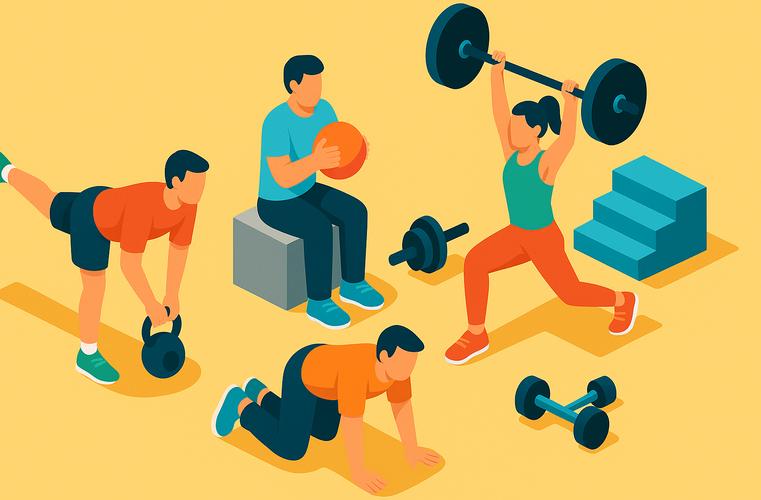What Functional Fitness Actually Means
Functional fitness isn’t just a marketing buzzword cooked up by someone trying to sell kettlebells. It refers to training that improves your ability to perform everyday tasks efficiently and safely. Think movements like pushing, pulling, squatting, rotating, carrying — you know, the things you do every time you move house, haul groceries, or try to wrangle an unwilling pet into a carrier.Where traditional training often isolates muscles — like bicep curls or leg extensions — functional fitness emphasizes movement patterns and coordination across multiple joints and muscle groups. It’s the difference between practicing a handshake versus practicing judo.
How It Differs From Traditional Training
Let’s say you’re hitting the gym and decide to bench press your way to glory. That’s great for chest strength, but unless your daily life involves pushing barbells off your sternum, the movement doesn’t have a huge practical carryover. Functional training asks: *Can you press something overhead while balancing on one leg and managing a twisting motion through your torso?*This type of training usually involves:
- Compound movements using multiple joints
- Stability and balance under dynamic conditions
- Use of free weights, resistance bands, and bodyweight
- Core activation with nearly every movement
Real-World Benefits: Why It Actually Matters
This isn’t just about looking cool while doing Turkish get-ups in a crowded gym. Functional training prepares your body for real-world scenarios. Lifting your kid into the car seat without tweaking your back? That’s functional strength. Hiking a steep hill without turning your knees into jelly? Also functional strength.It’s particularly important as we age. Mobility, balance, coordination — all the unglamorous stuff we tend to overlook — starts to matter a lot more once gravity develops a personal vendetta against your joints. Functional fitness keeps those capacities sharp, so the floor doesn’t win next time you drop your keys.
Injury Prevention Without the Bubble Wrap
One of the most overlooked — but crucial — benefits of functional fitness is how it trains the body to handle unpredictable, real-life movements. Most gym injuries don’t happen when someone’s performing a lift they’ve practiced a hundred times. They happen during an awkward twist, a sudden reach, or that heroic lunge to catch a falling phone.Functional training creates resilience through variability. By incorporating different planes of movement, tempo changes, and unstable surfaces, you’re teaching your body how to stabilize under pressure — quite literally. Joints become more adaptable, muscles work together rather than in isolation, and the nervous system gets better at coordinating complex actions.
So when life throws a curveball — or a rogue LEGO brick under your heel — you’re more likely to recover with dignity intact.
Mental Payoffs and the Confidence Dividend
There’s a mental shift that happens when your training actually relates to life. Suddenly, stairs aren’t enemies. Luggage doesn’t feel like an existential threat. You become the person who offers to move the couch, not just hold the door. That kind of confidence isn’t abstract — it’s built rep by rep.Even better, functional training tends to be engaging. No more robotic sets on clunky machines while silently resenting the pop music playing overhead. Instead, you might be crawling, carrying, throwing, balancing, or reacting. The body thrives on novelty, and functional fitness dishes it out without veering into circus territory.
Getting Started Without Building a Backyard Obstacle Course
You don’t need fancy gear or a gym that looks like a ninja academy. A well-rounded functional routine can be built with just bodyweight, some resistance bands, and maybe a dumbbell or two. Think practical, not theatrical.- Squats and lunges that mimic real-world movement
- Pushes and pulls in multiple directions
- Core work with rotation, anti-rotation, and stability focus
- Loaded carries for grip and total-body tension
Function Before Fashion
Functional fitness doesn’t always look glamorous. There are no mirrors involved when you’re crawling across the floor like a toddler on a mission. But its value is in the results you don’t post on social media — fewer injuries, more mobility, and strength that shows up in all the places that matter: carrying groceries, climbing stairs, picking up kids, or outrunning a surprisingly fast goose.When training stops being about aesthetics or chasing numbers and starts being about real-life usefulness, things click. Functional fitness isn’t the only way to train — but for many, it’s the missing piece between being strong and being truly capable.
And if it means you can finally lift that overstuffed suitcase into the overhead bin without praying for a sympathetic flight attendant, that’s a win for everybody.
Article kindly provided by fightgravityfit.com

